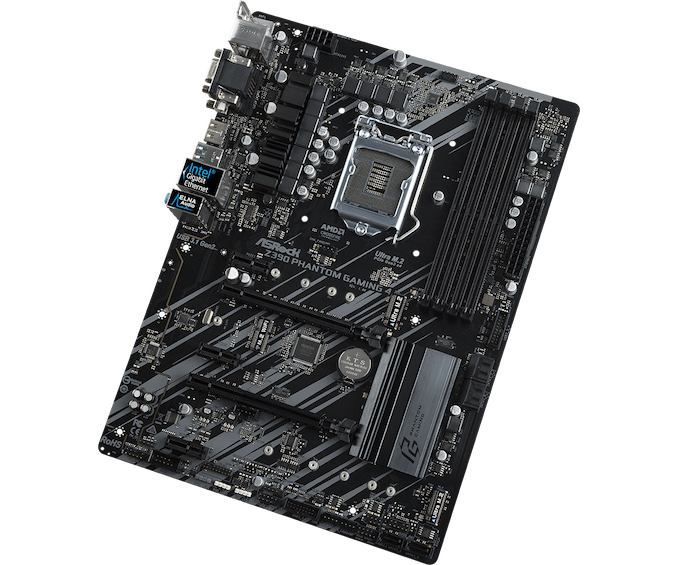Intel Z390 Motherboard Overview: 50+ Motherboards Analyzed
by Ian Cutress & Gavin Bonshor on October 8, 2018 10:53 AM EST- Posted in
- Motherboards
- Intel
- MSI
- Gigabyte
- ASRock
- EVGA
- Asus
- NZXT
- Supermicro
- Z390
ASRock Z390 Phantom Gaming 4
With the Z390 Phantom Gaming 4, ASRock has dropped the flashy LED lighting integrated into the heatsinks and offers users a further cut-down version at an entry-level price point ($140). The Z390 Phantom Gaming 4 keeps the same black and grey PCB theme, it removes the rear panel cover from the other Phantom Gaming boards outlined above and removes one of the power delivery heatsinks; this model is advertised as having a lower spec 10-phase power delivery. Also omitted from the Z390 Phantom Gaming 4 is Steel Slot protection. The board has two full-length PCIe 3.0 slots which run at x16 and x4 respectively, along with a total of three PCIe 3.0 x1 slots. Users looking to run SLI on a budget will need to look at ASRock's Z390 Phantom Gaming SLI board which is similar but costs $20 more.
The memory capability of the Z390 Phantom Gaming 4 consists of support for up to 64 GB of DDR4 memory and up to DDR4-4300. The board offers six SATA ports with support for RAID 0, 1, 5 and 10 arrays. Included are two PCIe 3.0 x and SATA compatible M.2 slots and on the cooling front, the Z390 Phantom Gaming 4 offers a total of four 4-pin fan headers.
On the rear panel, the Z390 Phantom Gaming 4 has two USB 3.1 Gen2 consisting of a single Type-A and Type-C port with two USB 3.0 Type-A and USB 2.0 ports. A single LAN port powered by an Intel I219V Gigabit networking controller and the three 3.5 mm audio controlled by a Realtek ALC892 HD codec are also featured. Just like the Z390 Phantom Gaming 6, the Z390 Phantom Gaming 4 has a trifecta of video outputs which are comprised of a D-sub, a DisplayPort and a single HDMI output.
With a much lower entry point into the market than the bigger Phantom Gaming 6 and 9 motherboards, the ASRock Z390 Phantom Gaming 4 has a price of $140 which makes it the third cheapest Z390 board in ASRock's current SKU list and with Intel Gigabit LAN and a mid-ranged Realtek ALC892 codec, the Gaming 4 is seemingly targeted at gamers not looking to spend allocated budget on flashy aspects such as RGB and SLI support, but instead sticks to the important core componentry with minimal fuss.












79 Comments
View All Comments
pawinda8 - Monday, October 15, 2018 - link
Still no mention of any Z390 boards with native Thunderbolt 3 (not AIC)! Has Intel given up on Thunderbolt for the PC world?gavbon - Monday, October 15, 2018 - link
If it's not integrated into the chipset, it's not really native as such. The ASRock Z390 Phantom Gaming-ITX/ac has a Thunderbolt 3 port on the rear panel, but that's the only one I'm afraidHikariWS - Monday, October 15, 2018 - link
Oculus Rift requires 3 USB3 ports and doesn't accept any of them being connected to a hub, they all need to be connected directly into a raw port. I had to buy a dedicated 3GIO USB 3 board that added 6 useful extra ports. In my (yes, old) Gigabyte z87 mobo I also had issues using keyboard and mouse on USB 3 ports inside UEFI and some recovery softwares, so I had to buy a USB 2 mirror to connect them.Because of that, having USB 2 ports on front panel and nice quantity of USB 3 is what most differs mobos for me, given that all other features are nearly the same.
ASUS Z390-A seems to be the best option. It has the important double USB2 ports, 5 USB3 ports and still has HDMI and DP for emergencies.
just4U - Monday, October 15, 2018 - link
I wish MSI had released a "godlike" board for the Ryzen series.ThugEsquire - Tuesday, October 16, 2018 - link
You list the ASRock Z390 Phantom Gaming-ITX/ac above as an ATX board, but it's actually mITX. FYIgavbon - Friday, October 19, 2018 - link
I have gone through every page where the Phantom Gaming-ITX/ac is listed, but I can't see where it says it's an ATX board? Could you please be more specific? Are you viewing on mobile or desktop?Galcobar - Tuesday, October 16, 2018 - link
It would be really helpful to break out one more criteria into a table: Type-C header for case-front ports.Helping a friend put together an i5 system and, knowing he'll keep it for a long time, am trying to get even with peripheral connectors (already has a monitor, so no using that as a hub). It's relatively easy to identify cases with a Type-C port, but that's pointless without a motherboard header. Having to go into each board's page to check is time-consuming.
jjnam - Thursday, April 18, 2019 - link
6 months later and I'm here for EXACTLY this reason. I've gone through probably 50 manuals over the past few days squinting to find this information. What a pain.Synomenon - Thursday, October 18, 2018 - link
So on the ASRock Z390 Phantom Gaming-ITX/ac, is the TB3 port on the rear using up lanes from CPU (making the only 16x slot, 8x only)?If it's not using lanes from the CPU, how will using that TB3 port (say with a USB3.1 Gen2 hub OR TB3 hub) affect all the other ports / IO on the board?
repoman27 - Thursday, October 18, 2018 - link
Going off of what TweakTown published, it's a single-port Intel JHL6240 "Alpine Ridge" controller with a PCI 3.0 x2 connection to the PCH. So it won't affect the PEG lanes from the CPU. I'm amazed it's not Titan Ridge at this point though.